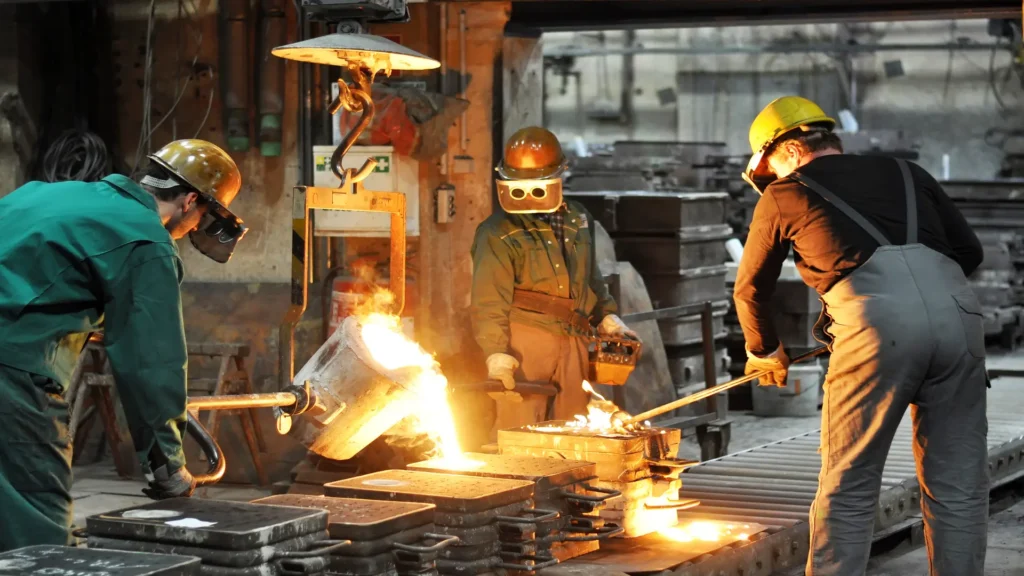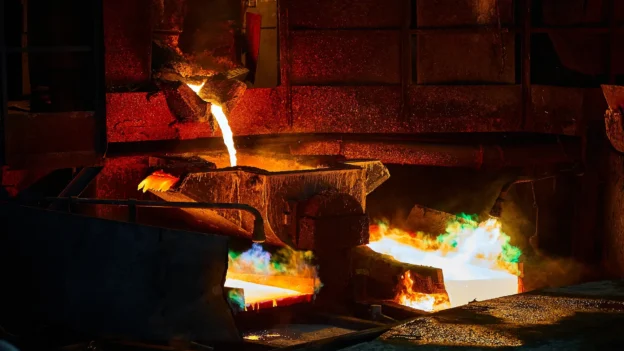Introduction
In the metallurgical industry and in numerous engineering fields, understanding the melting point of metals is an important aspect in the materials sector. This knowledge is significant in manufacturing and design processes, and also influences the selection of suitable materials for various applications. The melting point is the temperature at which a metal changes from a solid to a liquid state, and is a determining factor in the performance of metals under different operating conditions.
Knowledge about the melting point of metals allows decisions to be made about which materials to use in specific applications. For example, in industries where metals are exposed to high temperatures, it is critical to select those with high melting points to ensure the integrity and durability of structures. On the other hand, in applications that require welding or casting, understanding melting points helps to optimize these processes to improve the quality of the final product.
This article addresses considerable questions related to the melting point of metals. What is melting point? What are the metals with the highest melting points? We will explore how this factor impacts the life cycle of metals, from their extraction and processing to their final use in various industrial applications.
Melting point of metals
What is the melting point?
The melting point of a metal is the temperature at which a metal changes from a solid to a liquid state. This point is a fundamental physical property of materials and varies significantly between different metals. Accurate knowledge of the melting temperature of a metal is essential for various industrial processes, such as metal casting and component manufacturing1.
Metal casting is a process where metal is heated to its melting point, poured into a mold and allowed to cool to form a solid part. Without accurate knowledge of the melting point, this process could be inefficient or even fail, affecting the quality and integrity of the final product.
Melting points of metals vary widely. For example, the melting point of iron is 1538 °C, while that of aluminum is 660.3 °C. These values are crucial in determining the processing methods and applications of each metal. The melting point table of the most common metals provides a quick and useful reference for engineers and scientists.
What are the metals with the highest melting points?
Among the metals with the highest melting points are tungsten and osmium. Tungsten, with a melting point of 3422 °C, is used in applications requiring high-temperature resistance, such as lamp filaments and cutting tools. Osmium, with a melting point of 3033 °C, is less common but equally valuable in specialized applications.
Other metals with high melting points include rhenium (3186 °C) and tantalum (3017 °C). These metals are used in extreme environments, such as in aircraft engines and nuclear reactors, where high-temperature resistance is critical for safety and performance.
Melting point table of the most common metals
The following table shows some melting points of metallic materials.

Melting processes
Metal casting is a key industrial process where the melting point plays an important role. During casting, metal is heated to its melting point, poured into a mold and cooled to form a solid part. This process is used to manufacture a wide variety of components, from automotive parts to building structures. The choice of casting method and furnace type depends largely on the melting point of the metal to be processed.

Casting can be divided into different types according to the method used. Sand casting, for example, is a commonly used technique for metals with lower melting points, while lost-wax casting is suitable for metals with higher melting points due to its precision and ability to handle elevated temperatures.
Melting point in the life cycle of metals
The melting point of metals has a significant impact on all stages of a metal’s life cycle, from mining and processing to end use and recycling. At the smelting stage, the melting temperature of a metal determines the appropriate furnace type and smelting process. For example, aluminum smelting requires furnaces operating at relatively low temperatures, while iron smelting requires furnaces capable of much higher temperatures.
In addition, melting point influences the selection of materials for specific applications. Metals with high melting points are preferred in high-temperature environments, such as in the aerospace and energy industries. On the other hand, metals with lower melting points may be more suitable for applications that do not require high-temperature resistance. This value is critical in the metallurgical industry and in many fields of engineering. The following explores various facets of the importance of melting point in the life cycle.
1. Manufacturing processes and design
The melting point is crucial in determining metal processing techniques. In casting, for example, metals must be heated to their melting point in order to be shaped. Metals with high melting points, such as tungsten, require specialized furnaces and advanced techniques because of the high temperatures involved. On the other hand, metals with lower melting points, such as lead, can be handled with less sophisticated equipment.
The design of metal components also depends on the melting point. During material selection, engineers must consider the operating temperatures of the environment in which the component will operate. A metal with a low melting point would not be suitable for applications where it is expected to be exposed to high temperatures, as it could melt or lose its mechanical properties.
2. Selection of materials
The selection of materials for different applications is based in part on the melting point of the metals. Metals with high melting points, such as titanium and nickel, are preferred in applications requiring high-temperature resistance, such as in the aerospace and defense industry. These metals retain their structural integrity and mechanical strength under extreme conditions.
In the automotive industry, metals that can withstand the high temperatures generated by engines and exhaust systems are sought after. Steel and its alloys are commonly used due to their high melting point and resistance to thermal deformation.
3. Durability and service life
Melting point also influences the durability and service life of metals. Metals exposed to temperatures close to their melting point can suffer premature deformation and failure. Therefore, understanding the melting point helps to predict and prevent wear of metal components under specific thermal conditions.
4. Innovations in metallurgical processes
Knowledge of the melting point has led to innovations in metallurgical processes. Technologies such as friction welding and powder metal sintering have been developed to take advantage of the different melting points of materials, allowing the creation of stronger products with better mechanical properties.
5. Impact on sustainability
The efficiency of energy use in casting and manufacturing processes is directly related to the melting point of metals. Metals that melt at lower temperatures require less energy to be processed, which contributes to the sustainability of industrial operations. Reducing energy consumption not only reduces costs, but also reduces greenhouse gas emissions, helping to mitigate the environmental impact of the metallurgical industry.
Applications of melting points of metals in different industries
Welding industries
In the welding and fabrication industries, the melting point of metals is a crucial factor. Welding involves the melting of two or more pieces of metal to form a solid joint. Knowing the melting point of the metal allows the proper temperature to be selected to avoid weld defects such as cracking or deformation. Metals with lower melting points, such as tin or lead, are commonly used in soldering electronic components because of their ability to melt at relatively low temperatures, protecting heat-sensitive components.
Metallurgy and manufacturing processes
In metallurgy and manufacturing processes, the melting point determines the techniques used for handling and forming metals. For example, casting involves heating metal to its melting point and pouring it into a mold to shape it. Metals such as aluminum and iron, with relatively high melting points, require high-temperature furnaces and advanced techniques for handling. In addition, melting point also influences the heat treatments applied to metals to improve their mechanical and structural properties.
Aerospace and defense industry
In the aerospace and defense industry, materials must withstand extreme conditions, including high temperatures and mechanical stresses. Metals with high melting points, such as titanium and nickel alloys, are essential in the manufacture of jet engine components and aircraft structures. These materials provide the strength and durability needed to operate safely and efficiently in demanding environments. In addition, in military applications, these metals ensure that equipment can withstand high temperatures generated by friction and explosions.
Automotive industry
In the automotive industry, the melting point of metals plays a key role in the manufacture of engine components and exhaust systems. Metals such as steel and aluminum are widely used due to their ability to withstand the high temperatures generated during engine operation. In addition, knowledge of melting point is vital in the casting and welding processes used in the production of chassis and other structural parts, ensuring the integrity and safety of vehicles.
Melting points of metals in chemical research and development processes
In chemical research and development processes, the melting points of metals are critical for designing experiments and developing new materials. Metal catalysts, which often have to operate at high temperatures, require metals with adequate melting points to maintain their stability and efficiency. In addition, the study of melting points allows scientists to develop alloys and compounds with specific properties for advanced applications in fields such as nanotechnology and semiconductor manufacturing.
Conclusions
The melting point of metals is a critical parameter that affects all stages of the life cycle of metals, from their processing and design to their selection and use in industrial applications. Understanding and applying this knowledge is essential to optimize the durability, efficiency, and sustainability of metallurgical projects. This article has explored how melting point influences various industries and its importance in technical and strategic decision-making.
Understanding the melting point of metals is essential for the metallurgical industry and many other engineering applications. From casting to material selection and component manufacturing, knowledge of a metal’s melting temperature ensures the efficiency and quality of the final product. The melting point table of the most common metals is a valuable tool for engineers and scientists, helping them to make informed decisions about which processes and materials to use.
The melting point of metals not only determines how metals are processed and used but also influences their entire life cycle, from extraction to recycling, ensuring the durability and functionality of metal structures and components. The correct application of this knowledge makes it possible to optimize industrial processes, improve safety and efficiency, and extend the service life of metal products in various industries.
References
- Brown, T. L., LeMay, H. E., Bursten, B. E., & Murphy, C. J. (2009). Chemistry: The Central Science (11ª ed.). Pearson Education
- https://fdiazuceda.blogspot.com/2016/02/tecnologia-2-eso-tema-4-los-metales.html


